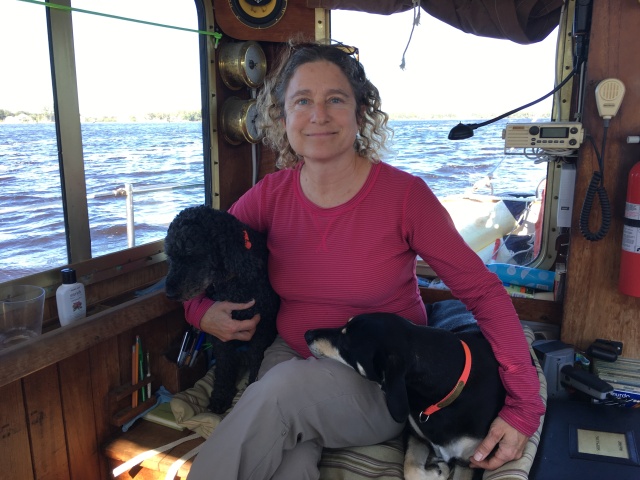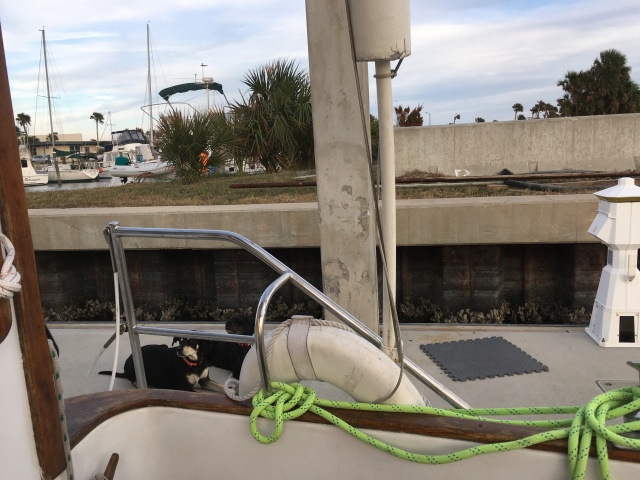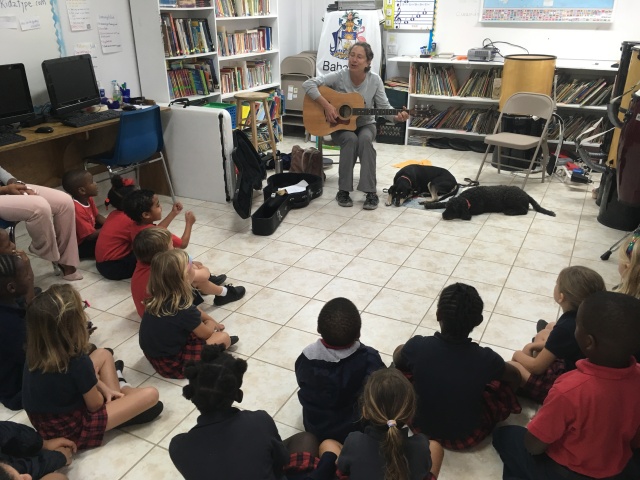 Teaching your dog to relax on leash, play nicely with other dogs, settle in one place, relax around distractions, begins with tether training. These simple training principles apply not only to tether training, but also to training any cue.
Teaching your dog to relax on leash, play nicely with other dogs, settle in one place, relax around distractions, begins with tether training. These simple training principles apply not only to tether training, but also to training any cue.
Start by making it easy, with short duration, no distractions, and build slowly to reward greater difficulty, duration, distractions. Teach all the pieces of behavior separately, and then put them together. When the dog is responding perfectly, you can start to “shrink” your cue(s).
First, I’ll show you the “finished” behavior. In the picture below, my two boat dogs are in an unfamiliar area, surrounded by high distractions. They are very experienced. I no longer need to tether the leash, but I leave the leashes on as a conditioned cue, to help make difficult behavior (people, dogs, birds, boats all moving around them) feel easier. Unhooking the leash is an example of how a trainer might “shrink” a cue. I was practicing having them lay down and wait, and then go to a target (the mat) from a distance.

Initial cues for “tethering” are a leash and (highly recommended but not essential) mat.
- Begin by introducing the leash. Clip it on, feed a treat, and take it off. With puppies, clipping the leash on and off is also a foundation for learning to come when called. Hold up the leash, clip it on, feed her, and take it off. Practice in a small room with no distractions, such as the kitchen. Then, practice in a fenced-in yard. Soon, she will come running when you hold up the leash.
- Introduce the mat. During dinner times, feed the puppy on the mat, and then put it away. This mat should be a special one.
- For dinner, put it inside a crate with the door open. When s/he is done eating, encourage her to get out of the crate, and lock her out of the crate. Later, if she is asking to get the food out of the crate, you can open the crate door for her and release her to get the food. After eating, put the mat and food or treat away.
- Separately, play crate games with your puppy. At night, take your puppy’s small crate into bed with you, and you can leave your arm in the crate with your puppy. Night two, set the crate on a bedside table, with your fingers or arm inside the crate with your puppy. As your puppy grows, get a larger and larger crate and set it on the floor beside your bed. Don’t wait for your puppy to fuss before you release him from the crate. Take him out of the crate BEFORE he fusses. Review our crate games videos.
- When you begin tether training, the puppy or dog should already love to see the leash as well as the mat. As you can see, if you practice feeding on a mat in the crate, it helps condition a relaxed quiet feeling in the crate as well! This comes in very handy when you travel or participate in fun dog events.
- Now, grow duration: Loop a non-chewable leash handle over the outside door handle, and close the door, so your dog is tethered indoors, and lay the mat beside it. The dog should naturally go to the mat, expecting a chew! Clip on the tether, feed, then unclip, and give your release cue (“okay! go play!”). If the dog wants to, practice three or four times, and then put the gear away. Hopefully the dog is disappointed to see it go! Tethering your dog will also help you to remember that you need to release your dog, rather asking her to “down” and forgetting about her, letting her decide when she can release herself. Vary the locations and duration, keeping it easy and fun for you dog to practice staying in one location for 1 to 3 minutes. Only food reward when on the mat. After the session is over, put the mat and the food away.
Trick: Make your reward memorable by prolonging treat delivery. Rather than multiple gulp and forget treats, try giving a chewy bone, or breaking one treat into many small pieces and feeding them like spaghetti,stringing it out to make it last. Ideally, she should be in the down position as she is eating.
Step it up a notch! Use this game to condition a “keep going signal” (KGS) .
The KGS helps you build duration on ANY behavior by inserting “yay!” between other reinforcers. Give a praise and treat in the down position. Say “yay,” then quickly give another treat. Unclip and release with “go play!” You can tell you’re doing great if you have to say “go play” more than once! Leave ’em wanting more!
The word “yay” is becoming a “conditioned encouragement” signal, that lets her know a reward is coming. You can use it to help you build duration.
6. If she stands up (or makes any mistake!) after you say “yay!” just say “oopsie!” and wait. If she lays back down say “yay!” enthusiastically,nclick and give her the bone to chew.
A KGS is not a reward marker. Unlike the Reward Marker Signal (RMS), or “click,” and KGS doesn’t guarantee reward, but it lets the animal know “you’re headed in the right direction!” We are training “yay” versus “oopsie, ” that is, “conditioned encouragement” versus “conditioned discouragement.” Because “oopsie” can be discouraging, we should avoid using it more than once. If it is not immediately helping the dog to find the prize, change your strategy and make the exercise easier.
Important! Before she has a chance to get bored or fuss, release her and put all the gear and fun stuff away. Never overwork your puppy. Don’t try to push her to do more than s/he is ready to do. If you know she can’t do it, don’t. S/he should be happy to see the mat and tether and crate come out, and she should never find out that there might be any reason to sneak off when you aren’t looking. You are not feeding her to hold her in place, but instead you are giving her energy for relaxing on the tether. Eventually, you’ll be able to practice leaving the room for just a second, and come back in, and give her a treat.Over time, you could also practice having someone else deliver your dog a treat on the mat, while you are standing on the other side of the room. Keep sessions short and successful and don’t aim for extreme durations.
Prevent problems! As with crate training, don’t give attention and food to stop a dog from fussing. Generously praise and food/chew/toy reward quiet unfussy behavior. Release your dog before there is any whining/ complaining.
Know your dog. If your dog has previously had bad experiences on leash or tether, make this game brief, easy, highly rewarding. Use roast beef for a treat and practice just for one second, several times per day.
Obviously, don’t tether your dog in the hot sun, or the cold lonely basement, or when she needs to go to the bathroom, or where another dog (or cat!) can harass or hurt her. Practice tether training after a nice walk, or during dinner when she is tired after a long day. Just as true of you, your dog must feel safe and comfortable, or she will not be able to learn.
Trouble shoot: If you goof up and the puppy is barking or misbehaving on the tether, crate or gate her (even if for just a minute) and put away the toys and treats. Don’t get mad for heavens sake. And don’t punish it. Just don’t reward it. Make it easier next time by sitting with her, petting her, settling her down and then release her. You want the dog to learn, when you respond to cues, you hang out off leash. If you’d prefer to take a nap in the crate, wild naughty behavior will surely get you there.
How to use the tether: If a loose puppy is harassing an older dog, tethering is a great way to give puppy-wuppy a “handicap.” Tethering puppy allows the older loose pet to interact and play, and then escape from the little terror! Tethering makes it easy to practice distance behaviors. Tethering makes it easy to capture “down” and sit, and put these on cue with a reinforcement marker signal (RMS) or clicker.
Never leave the dog tied up unsupervised, as they are vulnerable to being stolen, attacked, or strangling. I tether my dog while I walk an agility course or while I help a classmate with her dog. I have my dogs wait (they think of it as being tethered) on the dock while I am climbing off the boat. They are often “tethered” (waiting on a mat) when I am on the beach. In classrooms I use both the tether and mat and crate, and then I shrink those cues according to how the dogs are responding.
While ultimately the next cue or the release (“okay, let’s go!) becomes the reward, I continue to associate waiting on a tether or mat (or an imaginary mat/tether) with having a “nice time,” ie., regularly pet, praise, brush, feed and give chews to your dogs when they are waiting nicely on a mat or tether. As your dog becomes familiar with your evolving verbal cues ( I use “wait,” “mat” “down” “yay” and “oopsie” etc), your dog will be able to really understand and anticipate what is going to happen next. This ability to anticipate helps dogs relax and feel more confident, less frustrated.
Congratulations in reading this far! Please let me know in the comments area if you need any clarifications, or how your training is progressing! Your comments and questions are appreciated!
